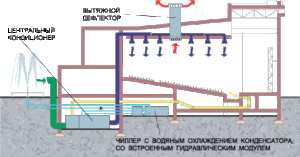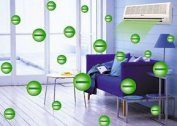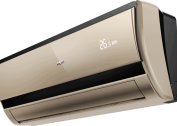Central air conditioning is the main part of the climate system that regulates the parameters of air in large areas. They are installed to maintain comfortable conditions in offices, indoor stadiums, production halls, and hotels. A centralized air conditioning system provides fresh air to each room. The final climate control is carried out by fan coil units (analogs of the indoor unit of the split system).
The principle of operation of the climate unit
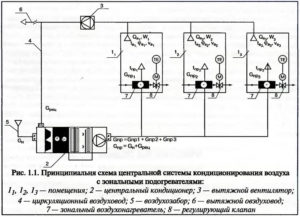 Central air conditioning systems consist of several parts:
Central air conditioning systems consist of several parts:
- The central air conditioner is a multi-sectional unit that carries out air intake and preparation.
- Chiller - a refrigeration unit that lowers the temperature of the refrigerant (water, glycol mixture).
- Fancoil is a heat exchanger installed in rooms for heating or cooling.
- Duct system - used to move air masses.
The principle of operation of the central air conditioner:
- Functioning fans draw street air into the system.
- Cleaning is carried out by filtering devices, removing up to 90% of contamination and impurities.
- The prepared air mass is moistened or drained to the specified parameters.
- Through an extensive system of ducts, conditioned air is sent to the serviced premises.
- A central air conditioner with recirculation mixes in different proportions of supply and exhaust air. The combination reduces energy consumption for processing street air.
Climate control is carried out using an automatic remote control mounted on the wall. Microprocessors control the temperature setting, changing modes, fan speed, compressor operation.
System design
 In the general case of the central air conditioner there are sections that perform certain functions. Their equipment depends on the brand and type of equipment. Standard set of modules:
In the general case of the central air conditioner there are sections that perform certain functions. Their equipment depends on the brand and type of equipment. Standard set of modules:
- Fan section. Purpose - providing air intake and supply to air-conditioned areas. Used centrifugal type devices.
- Cooling section. A heat exchanger consisting of copper tubes through which water or freon circulates. In the first case, the external source of cold is the chiller. When using freon as a refrigerant, the module is connected to the condensing unit.
- Filtration Section. The function of the module is to clean the injected air. The air conditioner uses two groups of filters: primary and secondary. At the initial stage, cleaning is carried out with devices of class EU1-EU3, which remove up to 60% of dust. The second step is the use of fine filters EU5-EU6, delaying 90% of pollution. The catching elements are mounted on a frame with a sealant. Central air conditioning units are equipped with synthetic corrugated, bag, absorption, deodorizing filters.
- Heating section. Structurally resembles a cooling module (consists of tubes). It is completed with a water, steam or electric heater.
- Humidification section. The module is a steam humidifier or an irrigation chamber with a nozzle. Passing air is saturated with a shallow water suspension. After the section, a droplet eliminator is installed to prevent moisture from entering other parts of the equipment.
- Sound absorption section. Sound absorbing plates are installed to reduce the noise intensity.They are made of several layers of mineral wool or fiberglass. The plates muffle the fans.
The dimensions of the installation and each section depend on the required performance. Unit weight from 50 to 500 kg.
Features and Application
The central air conditioner is non-autonomous; for the functioning of the unit, the intake of cold and heat from outside is required. Its provision is carried out due to water from the chiller, connection to the heating system (boiler). Climatic equipment serving shopping malls and industrial facilities is characterized by high productivity from 500 to 120 thousand cubic / hour. Powerful equipment is designed with energy efficiency in mind. To increase the efficiency of the system allows heat recovery. Air conditioners operate in conjunction with chillers or condensing units. The central air conditioner is designed for several rooms, with a lack of power, two units are installed.
Application area
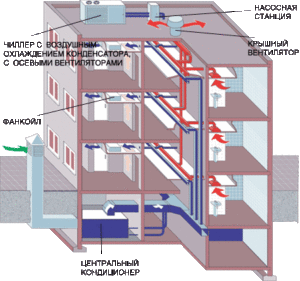 The equipment is used in the household, commercial, public and industrial sectors. Central units serve:
The equipment is used in the household, commercial, public and industrial sectors. Central units serve:
- office centers;
- medical institutions;
- concert halls;
- food production;
- pharmaceutical enterprises;
- shopping centers.
Advantages and disadvantages
Central air conditioners have several advantages over other types of climate technology:
- The central installation, which works on the entire building, is cheaper than the split systems in each room. The costs at the initial stage are offset by a small electricity consumption for the operation of the air conditioner.
- Installation of long communication lines is allowed, while power losses are minimal.
- Maintenance and repair of one main unit of the air conditioning system takes less time and is cheaper.
- Air conditioners are installed in technical rooms or on the roof. They do not spoil the interior, do not take up space. The noise of the fans does not bother employees and visitors.
- The system is capable of cooling or heating large volumes of air.
- Central air conditioners are designed to solve complex tasks. The equipment lowers temperature, heats, cleans, moisturizes and distributes air masses.
disadvantages
- A complex installation scheme, requiring the installation of hoods, laying ducts.
- Significant dimensions require allocation of space.
- The high cost of equipment.
Varieties of central air conditioners
Depending on the internal structure, units are divided into several types:
- Direct-flow. The system uses only outside air. Air conditioners are installed in buildings where air pollution is increased by dust, toxic fumes, microorganisms. The lack of direct-flow equipment in the cost of large capacities for heating and cooling.
- Recirculating. A mixture of supply and exhaust air circulates through the channels. Recycling is complete or partial. The air from the rooms is cleaned, moistened or dried, then sent back. The option is suitable for rooms without hazardous emissions.
- Recovery equipment. Air conditioners use extract air heat to partially heat the outdoor. In special heat exchangers (recuperators) there is a temperature exchange or mixing of air masses. The system provides less power consumption.
Central air conditioners are an efficient and reliable version of HVAC equipment. Their average cost is 200-250 thousand rubles. When servicing buildings with many rooms, these costs are justified.
